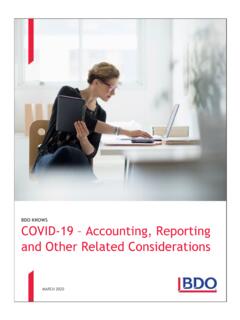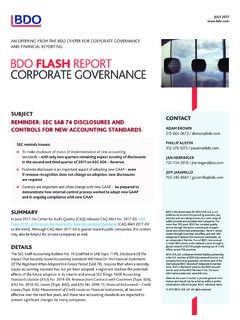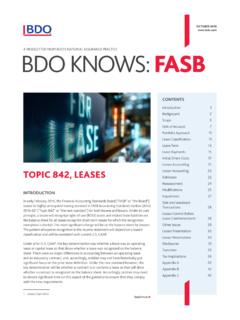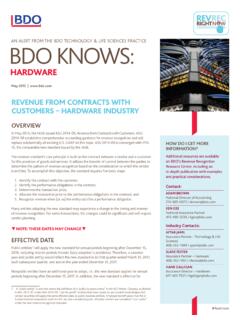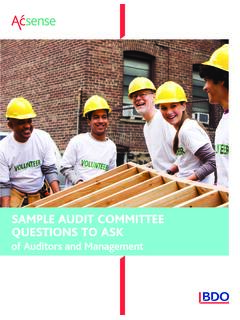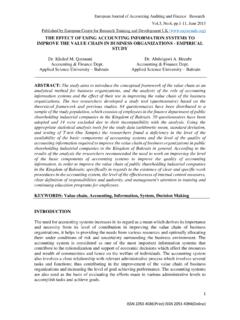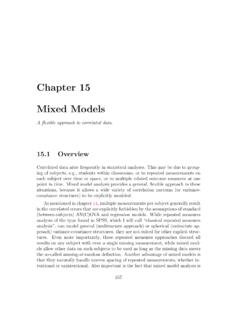Transcription of ACCOUNTING CHANGES AND ERROR CORRECTIONS
1 ACCOUNTING CHANGES ANDERROR CORRECTIONSC ontentsINTRODUCTION 1 ACCOUNTING CHANGES 2 ERROR CORRECTIONS 4 RECLASSIFICATIONS 8 OTHER CONSIDERATIONS 9 IntroductionThe financial markets depend on high quality financial reporting A fundamental pillar of high quality public financial reporting is reliable, comparable financial statements that are free from material misstatement ACCOUNTING CHANGES and errors in previously filed financial statements can affect the comparability of financial statements In this publication, we provide an overview of the types of ACCOUNTING CHANGES that affect financial statements, as well as the disclosure and reporting considerations for ERROR CORRECTIONS While the guidance included herein is not a substitute for the exercise of professional judgment or professional ACCOUNTING advice.
2 We hope that you find it a useful starting point when assessing the financial reporting ramifications of ACCOUNTING CHANGES and errors in previously issued financial statements 1 ACCOUNTING CHANGES AND ERROR CORRECTIONSA ccounting ChangesAccounting Standards Codification (ASC) Topic 250, ACCOUNTING CHANGES and ERROR CORRECTIONS , addresses certain circumstances that require special ACCOUNTING or disclosure, including: XChange in ACCOUNTING Principle; XChange in ACCOUNTING Estimates; XChange in Reporting Entity; and XCorrection of an ERROR in Previously Issued Financial Statements. ACCOUNTING CHANGES are those in the first three categories above. In order to understand the ACCOUNTING and disclosure obligations for each of these categories, it is helpful to begin with a basic understanding of their meaning: change IN ACCOUNTING PRINCIPLEA change in ACCOUNTING principle is defined as: A change from one generally accepted ACCOUNTING principle to another generally accepted ACCOUNTING principle when (a) there are two or more generally accepted ACCOUNTING principles that apply; or (b) the ACCOUNTING principle formerly used is no longer generally accepted.
3 A change in the method of applying an ACCOUNTING principle also is considered a change in ACCOUNTING principle. A change in ACCOUNTING principle is applied for two types of CHANGES : XMandatory CHANGES required by a newly issued ACCOUNTING Standard Update (ASU); or XVoluntarily CHANGES from one acceptable ACCOUNTING principle to another on the basis that it is preferable. Newly issued ASUs include specific transition and disclosure guidance for the period of adoption. Voluntary CHANGES in ACCOUNTING principles should be applied retroactively to the beginning of the earliest period presented in the financial statements ( , so that the comparative financial statements reflect the application of the principle as if it had always been used), unless it is impracticable to do so.
4 If retrospective application is impractical, the change should be adopted as of the beginning of a fiscal year. Whether it impracticable to apply a new principle on a retrospective basis requires a considerable level of judgment. 11 Further considerations about the impracticability exception can be found in ASC : ASC 250 presumes that an entity will apply ACCOUNTING principles consistently unless new ASUs are issued. The preferability analysis required to justify a change from one generally accepted ACCOUNTING principle to another generally accepted principle also requires a considerable level of judgment and coordination with an entity s independent accountant. An SEC registrant is required to file a preferability letter from its independent accountant concurring with its conclusion that such a change was preferable.
5 Additional guidance and information with respect to the preferability assessment can be found in ASC 250-10-S99-4 (codified from Staff ACCOUNTING Bulletin (2)(b)1).It is important to distinguish the treatment from a change in ACCOUNTING principle, as defined above, from a change that results from moving from an ACCOUNTING principle that is not generally accepted to one that is generally accepted. This type of change is an ERROR correction refer to ERROR CORRECTIONS section for further entity is required to disclose the nature of and reason for the change in ACCOUNTING principle, including a discussion of why the new principle is preferable. The method of applying the change , the impact of the change to affected financial statement line items (including income from continuing operations and earning per share), and the cumulative effect to opening retained earnings (if applicable) must be disclosed.
6 Additional disclosures are required for any indirect effects of the change in ACCOUNTING principle. Financial statements of subsequent periods are not required to repeat these disclosures. If the change in ACCOUNTING principle does not have a material effect in the period of change , but is expected to in future periods, any financial statements that include the period of change should disclose the nature of and reasons for the change in ACCOUNTING principle. 2 ACCOUNTING CHANGES AND ERROR CORRECTIONSCHANGE IN ACCOUNTING ESTIMATEA change in ACCOUNTING estimate is: A change that has the effect of adjusting the carrying amount of an existing asset or liability or altering the subsequent ACCOUNTING for existing or future assets or liabilities.
7 A change in ACCOUNTING estimate is a necessary consequence of management s periodic assessment of information used in the preparation of its financial statements. CHANGES in ACCOUNTING estimates result from new information. Common examples of such CHANGES include CHANGES in the useful lives of property and equipment and estimates of uncollectible receivables, obsolete inventory, and warranty obligations, among others. Sometimes, a change in estimate is affected by a change in ACCOUNTING principle ( , a change in the depreciation method for equipment). A change of this nature may only be made if the change in ACCOUNTING principle is also preferable. Note: A critical element of analyzing whether a change should be accounted for as a change in estimate relates to the nature and timing of the information that is driving the change .
8 Companies should carefully assess whether such information is truly new information identified in the reporting period or corrects inappropriate assumptions or estimates in prior periods (which would be evaluated under the ERROR correction guidance). For example, a change made to the allowance for uncollectible receivables to include data that was accidentally omitted from the original estimate or to correct a mathematical ERROR or formula represents an ERROR correction . Conversely, a change made to the same allowance to incorporate updated economic data ( , unemployment figures) and the impact it could have on the customer population would represent a change in estimate. A change in estimate is accounted for in the period of change if the change affects that period only or in the period of change and future periods if the change affects both.
9 A change in ACCOUNTING estimate is not to be accounted for by restating or retrospectively adjusting amounts reported in previously issued financial statements or by reporting pro forma amounts for prior entity is required to disclose the impact of the change in ACCOUNTING estimates on its income from continuing operations, net income (including per share amounts) of the current period. If the change in estimate is made in the ordinary course of ACCOUNTING for items such as uncollectible accounts or inventory obsolescence, disclosure is not required unless the effect is material. If the change in estimate does not have a material effect in the period of change , but is expected to in future periods, any financial statements that include the period of change should disclose a description of the change in estimate.
10 change IN REPORTING ENTITYA change in reporting entity is: A change that results in financial statements that, in effect , are those of a different reporting entity. A change in reporting entity is generally limited to the following types of CHANGES : XPresenting consolidated or combined financial statements in place of financial statements of individual entities; XChanging specific subsidiaries that make up the group of entities for which consolidated financial statements are presented; and XChanging the entities included in combined financial in the reporting entity mainly transpire from significant restructuring activities and transactions. Neither business combinations accounted for by the acquisition method nor the consolidation of a variable interest entity (VIE) are considered CHANGES in the reporting financial statements of periods in which there has been a change in reporting entity, an entity should disclose the nature of and reasons for the change .
